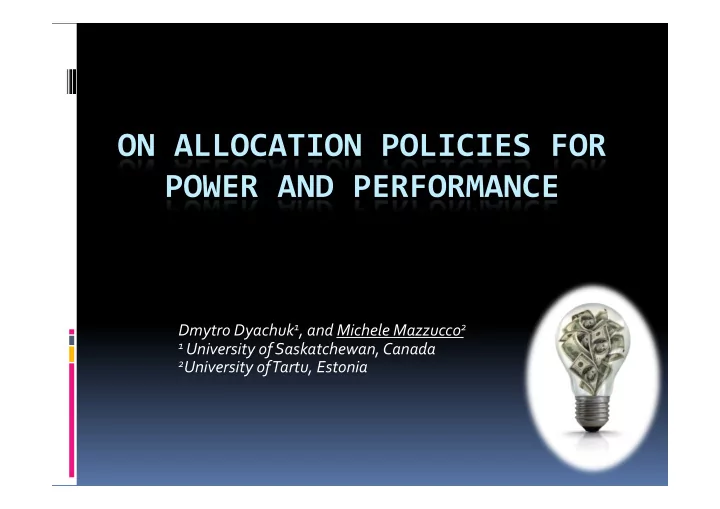

Dmytro ¡Dyachuk 1 , ¡and ¡Michele ¡Mazzucco 2 ¡ 1 ¡University ¡of ¡Saskatchewan, ¡Canada ¡ 2 University ¡of ¡Tartu, ¡Estonia ¡
Introduction ¡(1) ¡ Clients ¡have ¡performance ¡expectations ¡ Load ¡changes ¡over ¡the ¡time ¡ QoS ¡is ¡one ¡of ¡ ¡the ¡critical ¡factors ¡determining ¡the ¡ success ¡(or ¡failure) ¡of ¡service ¡providers ¡ E.g., ¡Google ¡reports ¡that ¡ ¡an ¡extra ¡0.5 ¡sec. ¡in ¡search ¡page ¡ generation ¡would ¡ ¡imply ¡a ¡20% ¡traffic ¡drop ¡ E.g., ¡trimming ¡the ¡page ¡size ¡of ¡ ¡Google ¡Maps ¡by ¡30% ¡ resulted ¡in ¡30% ¡traffic ¡ ¡increase ¡ 2
Introduction ¡(2) ¡ Electricity ¡bill ¡constitutes ¡a ¡significant ¡fraction ¡of ¡ the ¡datacenter ¡cost ¡ A ¡typical ¡household ¡consumes ¡1.14 ¡kW ¡ A ¡typical ¡data ¡center ¡consumes ¡15 ¡MW ¡= ¡877 ¡households ¡ ¡ ¡ ¡ Different ¡techniques ¡exist ¡for ¡reducing ¡energy ¡ consumption, ¡e.g., ¡voltage ¡scaling ¡ Idle ¡servers ¡consume ¡up ¡to ¡65% ¡of ¡their ¡peak ¡consumption ¡ Hence, ¡we ¡need ¡to ¡improve ¡data ¡center’s ¡utilization, ¡ i.e., ¡by ¡tearing ¡down ¡unused ¡servers ¡ How ¡many ¡servers ¡to ¡run? ¡ Over-‑provisioning ¡should ¡be ¡avoided ¡ Service ¡providers ¡ must ¡meet ¡performance/availability ¡ requirements ¡ ¡ 3
Problem ¡definition ¡ Suppose ¡we ¡have ¡a ¡collection ¡of ¡servers ¡ How ¡to ¡allocate ¡them ¡in ¡the ¡most ¡efficient ¡way? ¡ User ¡demand ¡is ¡very ¡unpredictable ¡ Each ¡successful ¡“transaction” ¡brings ¡c$ ¡: ¡we ¡don’t ¡want ¡to ¡miss ¡business ¡ opportunities ¡ 4
System ¡model ¡ S ¡servers ¡ n ¡are ¡running ¡ (S ¡-‑ ¡n) ¡ are ¡switched ¡off ¡ Every processed request generates a revenue of c$ ¡ Electricity ¡costs ¡r$ ¡per ¡kWh ¡ If ¡all ¡servers ¡are ¡busy, ¡further ¡jobs ¡are ¡queued ¡ But ¡clients ¡have ¡limited ¡patience! ¡ If ¡the ¡waiting ¡time ¡exceeds ¡a ¡certain ¡threshold ¡(i.e., ¡ 1/ θ on average ), ¡jobs ¡are ¡aborted ¡ How ¡to ¡choose ¡the ¡“best” ¡ n ? ¡ 5
Proposed ¡scheme ¡ • The performance of computing systems can be measured using different metrics • The goal of the service provider is to maximize the long-term average earned revenue per unit time Cost for electricity R = c ¡T ¡ ¡-‑ ¡ ¡rP ¡ Throughput Avg. revenue per job • For a given n and load, two variables are unknown and need to be estimated System throughput, T 1. Power consumption, P 2. • For the following we will use the notation R = r(n) 6
Power ¡usage ¡estimation ¡ Idle ¡servers ¡consume ¡up ¡to ¡65% ¡of ¡their ¡peak ¡consumption ¡ Avg. no. of busy servers Consumption when busy P ¡= ¡ne 1 ¡+ ¡T/μ ¡(e 2 -‑e 1 ) ¡ Consumption when idle 7
Adaptive ¡policy ¡(1) ¡ One ¡might ¡try ¡to ¡model ¡the ¡system ¡using ¡the ¡ Erlang-‑C ¡model ¡ 75% ¡of ¡people ¡won’t ¡visit ¡again ¡a ¡web ¡site ¡that ¡ took ¡more ¡than ¡4 ¡sec. ¡to ¡load ¡ We ¡do ¡allow ¡HTTP ¡timeouts ¡as ¡well ¡as ¡impatient ¡ customers ¡ ¡ … ¡but ¡Erlang-‑C ¡does ¡not ¡acknowledge ¡jobs ¡ abandonment ¡ 8
Adaptive ¡policy ¡(2) ¡ Based ¡on ¡the ¡Erlang-‑A ¡queuing ¡model ¡ At ¡each ¡allocation ¡epoch ¡ Compute ¡the ¡new ¡allocation, ¡n’ ¡ Use ¡the ¡traffic ¡estimates ¡to ¡evaluate ¡the ¡expected ¡ change ¡in ¡revenue, ¡ Δ r(n’,n) ¡ Δ r(n’,n) ¡= ¡r(n’) ¡-‑ ¡r(n) ¡– ¡Q ¡ Where ¡Q ¡is ¡the ¡cost ¡paid ¡for ¡powering ¡on ¡(off) ¡the ¡ |(n’-‑n)| ¡servers ¡ Carry out the new allocation only if Δ r(n’,n) ¡> ¡0 ¡ ¡ The ¡policy ¡is ¡implemented ¡as ¡a ¡binary ¡search ¡ algorithm ¡ ¡It ¡can ¡find ¡the ¡“best” ¡n ¡in ¡O(log ¡ ¡S) ¡iterations ¡ 9
QED ¡heuristic ¡ Large ¡server ¡farms ¡working ¡in ¡QED ¡regime ¡ balance ¡service ¡quality ¡and ¡server ¡efficiency ¡ Estimate ¡the ¡arrival ¡and ¡service ¡rates, ¡λ ¡and ¡ μ, ¡and ¡the ¡variance ¡of ¡λ, ¡Var(λ) ¡ Allocate ¡servers ¡according ¡to ¡ where ¡ α√ ¡is ¡used ¡to ¡deal ¡with ¡stochastic ¡variability, ¡and ¡ Var(ρ) ¡is ¡used ¡to ¡deal ¡with ¡not ¡deterministic ¡λ ¡ 10
Predictive ¡heuristic ¡(1) ¡ Load ¡changes ¡over ¡the ¡time, ¡it ¡follows ¡patterns, ¡etc. ¡ Allocate ¡servers ¡using ¡double ¡exponential ¡smoothing ¡ Adjusts the smoothed value Updates the trend 11
Predictive ¡heuristic ¡(2) ¡ This ¡policy ¡can ¡predict ¡the ¡arrival ¡rates ¡of ¡Wikipedia ¡with ¡91% ¡ accuracy ¡in ¡90% ¡of ¡the ¡cases ¡ ¡ From ¡the ¡distribution ¡of ¡the ¡relative ¡error, ¡we ¡can ¡compute ¡Var (λ) ¡to ¡use ¡with ¡the ¡QED ¡heuristic ¡ 12
Experiments ¡with ¡Wikipedia ¡traces(1) ¡ S=1,000, ¡r=0.1$/kWh, ¡c=6.2*10 -‑6 ¡$ ¡ 1/µ=0.1 ¡sec, ¡jobs ¡are ¡70% ¡CPU ¡bound, ¡θ ¡= ¡1/4 ¡ If ¡the ¡arrival ¡rate ¡is ¡unknown, ¡the ¡adaptive ¡policy ¡adjusted ¡with ¡90 th ¡ or ¡95 th ¡percentile ¡represent ¡the ¡best ¡trade-‑off ¡between ¡revenue, ¡ energy, ¡and ¡lost ¡jobs ¡ 13
Experiments ¡with ¡Wikipedia ¡traces(2) ¡ The ¡value ¡of ¡α ¡does ¡not ¡significantly ¡affect ¡R ¡ But ¡it ¡does ¡affect ¡the ¡number ¡of ¡lost ¡jobs ¡ QED ¡with ¡α ¡< ¡0.025 ¡performs ¡well ¡ 14
Experiments ¡with ¡Wikipedia ¡traces(3) ¡ The ¡value ¡of ¡α ¡does ¡not ¡significantly ¡affect ¡R ¡ But ¡it ¡does ¡affect ¡the ¡number ¡of ¡lost ¡jobs ¡ QED ¡with ¡α ¡< ¡0.025 ¡performs ¡well ¡ 15
Conclusions ¡ Deciding ¡how ¡many ¡servers ¡to ¡run ¡has ¡a ¡ significant ¡effect ¡on ¡the ¡revenue ¡ The ¡best ¡decision ¡depends ¡on ¡several ¡factors ¡ The ¡policies ¡we ¡propose ¡are ¡robust ¡against ¡errors ¡ in ¡parameters ¡estimation ¡ Future ¡work ¡ Deployment ¡in ¡a ¡real ¡server ¡farm ¡ Expand ¡the ¡framework ¡to ¡deal ¡with ¡ Multi-‑tiered ¡systems ¡ Different ¡workloads ¡(e.g., ¡compute ¡intensive ¡or ¡ storage ¡intensive) ¡ 16
Questions? ¡ • Dmytro Dyachuk dmytro.dyachuk@usask.ca • Michele Mazzucco michele.mazzucco@ut.ee 17
Recommend
More recommend